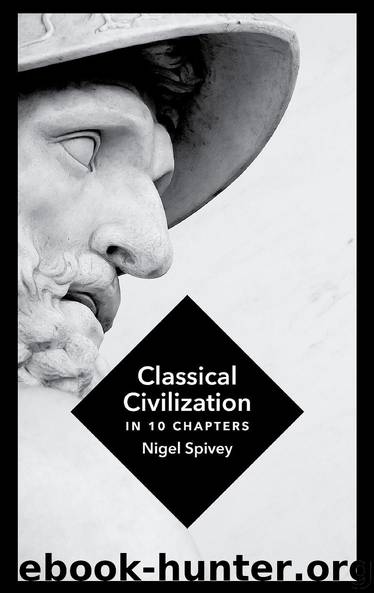Classical Civilisation by Nigel Spivey

Author:Nigel Spivey [Spivey, Nigel]
Language: eng
Format: epub
ISBN: 9781781854990
Publisher: Head of Zeus Ltd.
VII
Pergamon
The sense of the term ‘classical’, as observed in the Preface to this book, is mutable. It may encompass all of Graeco-Roman antiquity, or it may occupy a chronological space between the historical subdivisions of ‘archaic’ and ‘Hellenistic’. In this latter sense, ‘classical’ has implications for what comes before and what comes after – at least, it does so in the hands of historians who like to impose upon the past the vegetable metaphor of growth, efflorescence and decay. The analogy itself has a long history: for our purposes, it is sufficient to notice its prevalence among certain influential intellectual figures in eighteenth- and nineteenth-century Europe. For example, in his pioneering survey of ancient art, published in 1763, the German antiquarian J. J. Winckelmann outlined a scheme whereby Greek art, from its ‘seeds’ in the archaic age, matured into a ‘grand or high style’ that is epitomized in the mid-fifth century BC by the work of Pheidias; relaxed into ‘more grace and complaisance’ during the fourth century BC, and thereafter went into ‘decline’ and ‘fall’ under the ‘imitators’.
Winckelmann, writing from the vantage of the modern Enlightenment, saw liberty as key to the ‘flowering of the arts’. It followed, therefore, that as the democratic city-states of Greece – notably Athens – yielded to rule by Macedonian autocrats, this flower must wilt: ‘Art which received its life, as it were, from freedom, must necessarily decline and fall with loss of freedom.’ So, while Macedonian governors may have been generous with their patronage, this compromised the quality of the art produced. For Winckelmann, ‘prodigal flattery worked to the detriment of truth and industry in art’. In retrospect, his censure seems overstated: himself the beneficiary of patrons first in Saxony, then at the Vatican, did he not see how artists had flourished, for instance, under the Medici rulers of Renaissance Florence? But the sense that the Hellenistic age was one of decline would linger on.
The term ‘Hellenistic’ was invented by Winckelmann’s compatriot J. G. Droysen in the 1830s. As a scholar, Droysen is credited with developing the ‘great man’ style of history, exemplified by his youthful biography of Alexander the Great. When Droysen proceeded to the sequel of Alexander’s Successors, however, he resorted to a more generalized mode of defining an epoch – the epoch extending from Alexander’s ‘manhood’ (336 BC), through the Successors as dynasts, and ending with the death of Cleopatra, last of the Ptolemies, in 30 BC (though Droysen, a firm Lutheran, allowed a terminus with the birth of Christ). Adopting the word Hellenistes from its New Testament usage – there used to denote Jewish individuals or communities for whom Greek was the daily language of convenience – Droysen identified Alexander’s key legacy as one of cultural ‘fusion’ ( Verschmelzung ) between Greece and Asia. So the emphatic difference between ‘Hellenic’ and ‘Hellenistic’ is that ‘Hellenic’ is synonymous with ‘Greek’, while ‘Hellenistic’ means something like ‘in Greek style’. *1
Droysen’s ultimate purpose may have been to explain a remarkable phenomenon: how a strange cult launched from the shores of Lake Galilee became a major world religion.
Download
This site does not store any files on its server. We only index and link to content provided by other sites. Please contact the content providers to delete copyright contents if any and email us, we'll remove relevant links or contents immediately.
The Secret History by Donna Tartt(18160)
Red Sparrow by Jason Matthews(5195)
Harry Potter 02 & The Chamber Of Secrets (Illustrated) by J.K. Rowling(3555)
In a Sunburned Country by Bill Bryson(3366)
Drawing Cutting Edge Anatomy by Christopher Hart(3290)
Figure Drawing for Artists by Steve Huston(3268)
The Daily Stoic by Holiday Ryan & Hanselman Stephen(3109)
Harry Potter and the Prisoner of Azkaban (Book 3) by J. K. Rowling(3109)
Japanese Design by Patricia J. Graham(3000)
The Roots of Romanticism (Second Edition) by Berlin Isaiah Hardy Henry Gray John(2819)
Make Comics Like the Pros by Greg Pak(2758)
Stacked Decks by The Rotenberg Collection(2685)
Harry Potter and the Deathly Hallows (7) by J.K. Rowling(2550)
Draw-A-Saurus by James Silvani(2503)
Tattoo Art by Doralba Picerno(2484)
On Photography by Susan Sontag(2482)
Foreign Devils on the Silk Road: The Search for the Lost Treasures of Central Asia by Peter Hopkirk(2387)
Churchill by Paul Johnson(2362)
The Daily Stoic by Ryan Holiday & Stephen Hanselman(2343)
